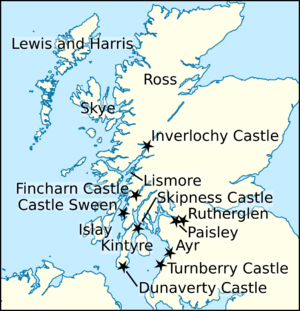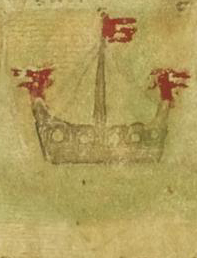Alasdair Óg of Islay facts for kids
Quick facts for kids
Alasdair Óg Mac Domhnaill
|
|
|---|---|
| Lord of Islay | |
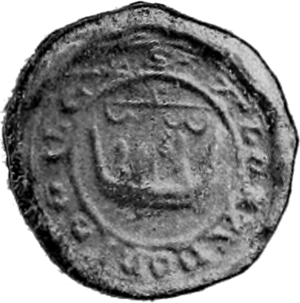
The seal of Alasdair Óg. It shows a ship with two men.
|
|
| Predecessor | Aonghus Mór mac Domhnaill |
| Successor | Aonghus Óg Mac Domhnaill? |
| Died | probably 1299 |
| Noble family | Clann Domhnaill |
| Spouse(s) | Juliana |
| Father | Aonghus Mór mac Domhnaill |
Alasdair Óg Mac Domhnaill (died around 1299) was an important leader in Scotland. He was the Lord of Islay and the chief of Clann Domhnaill, a powerful Scottish clan. He was the oldest son of Aonghus Mór mac Domhnaill, Lord of Islay.
Alasdair Óg first appears in history in 1264. He was held as a hostage by the Scottish King to ensure his father's good behavior. During his time, Scotland faced a big problem. The heir to the throne, Margaret, Maid of Norway, died unexpectedly in 1290. This led to a fight over who would be the next king.
One of the groups who wanted the throne was the Bruce kindred. Both Alasdair Óg and his father signed an agreement called the Turnberry Band. This agreement might have been about supporting the Bruces' claim to the throne.
Alasdair Óg became the chief of Clann Domhnaill around 1293. This was when his father, Aonghus Mór, was last mentioned in records. Alasdair Óg's wife was from Clann Dubhghaill, another powerful clan. This marriage led to conflicts over land between the two clans.
The chief of Clann Dubhghaill, Alasdair Mac Dubhghaill, supported John Balliol, who became King of Scotland. But King John was later defeated by Edward I, King of England. After this, Alasdair Óg joined forces with the English. He wanted to fight against Clann Dubhghaill. The English King used Alasdair Óg to control the west of Scotland. Clann Domhnaill spent the 1290s fighting against Clann Dubhghaill, Clann Ruaidhrí, and the Comyn kindred.
Alasdair Óg's rivalry with Alasdair Mac Dubhghaill likely led to his death. It seems he was killed by Alasdair Mac Dubhghaill in 1299. After his death, it's not clear who became the next chief of Clann Domhnaill. Alasdair Óg had at least six sons. His younger brother, Aonghus Óg, became a very important chief.
Over time, the leadership of Clann Domhnaill went to Aonghus Óg's descendants. Because of this, Alasdair Óg's story was often forgotten in later clan histories. However, many important gallowglass (mercenary warriors) families in Ireland came from Alasdair Óg's sons. These families were known as Clann Alasdair.
Contents
Family and Name
Alasdair Óg was an older son of Aonghus Mór mac Domhnaill, Lord of Islay. The Gaelic words Óg mean "young," and Mór mean "big." So, Alasdair Óg was "Alasdair the Younger." This helped tell him apart from his older uncle, Alasdair Mór mac Domhnaill.
His father, Aonghus Mór, was the son of Domhnall mac Raghnaill. Domhnall was the person who gave the Clann Domhnaill their name. Clann Domhnaill was one of the three main branches of Clann Somhairle. The other two were Clann Dubhghaill and Clann Ruaidhrí.
Alasdair Óg had several siblings. He had a sister who married Domhnall Óg Ó Domhnaill, King of Tír Chonaill. He also had a younger brother named Aonghus Óg. Another brother was Eóin Sprangach, who started the Ardnamurchan branch of Clann Domhnaill. He also had a sister who married Hugh Bisset.
The name Alasdair is the Gaelic version of Alexander. Aonghus Mór and his relative Eóghan Mac Dubhghaill (from Clann Somhairle) likely named their oldest sons after the kings of Scotland. Both Eóghan's son, Alasdair Mac Dubhghaill, and Alasdair Óg were probably named after Alexander III, King of Scotland. This is because they were likely born during his reign. Before Alexander II, the name "Alexander" was very rare in Scotland. But soon, important families started using royal names. This shows how Scottish influence was spreading. It also suggests that these clans wanted to be closer to the Scottish Crown.
Clann Domhnaill Under Aonghus Mór
Held as a Hostage
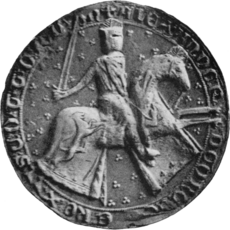
In the mid-1200s, King Alexander II and his son King Alexander III tried to bring the Hebrides islands into the Kingdom of Scotland. These islands were part of the Norwegian commonwealth. The independence of the islanders and the power of their Norwegian ruler, Hákon Hákonarson, King of Norway, worried the Scottish kings.
In 1261, King Alexander III tried to buy the islands from Norway. When talks failed, he sent an army to the islands. This was a direct challenge to Norway's power. King Hákon then gathered a huge fleet to show Norway's control. He met with his allies in the Isles, including Aonghus Mór. Hákon took over castles and raided the mainland.
After some battles and bad weather, the Norwegians went home. King Hákon died that December. Because Norway failed, King Alexander III took action. He launched more invasions into the Isles and northern Scotland. Magnús Óláfsson, King of Mann and the Isles, an island ruler, soon surrendered to the Scots. This showed that Norway's power in the Isles had completely fallen.
After Norway left and Scotland took control, Aonghus Mór had to surrender to the Scots. He was forced to give his son, probably Alasdair Óg, as a hostage. Alasdair Óg was held at Ayr to guarantee his father's good behavior. The fact that a nurse was with his son suggests he was a very young child at the time.
The Turnberry Agreement
Alasdair Óg is next mentioned around 1284-1286. He confirmed a gift his father made to a monastery. Records show that Clann Somhairle, over time, started to work more with Scottish people. This was instead of just people from the islands. In fact, Alasdair Óg's deal with the monastery is the first time Robert Bruce VII, who would become a future King of Scotland, is mentioned.
Clann Domhnaill also made alliances with different groups in Scotland. While Clann Dubhghaill joined with the powerful Comyn kindred, Clann Domhnaill sided with the Bruce kindred. This partnership likely happened after King Alexander III died unexpectedly in March 1286.
Even though the Scottish leaders had agreed that Alexander III's granddaughter, Margaret, was the rightful heir, two main groups claimed the throne. In April, Robert Bruce V, Lord of Annandale, announced his claim. John Balliol, supported by the Comyns, also claimed the throne.

The Bruce group might have felt their claim was weaker than the Comyn-Balliol group. In September, members of the Bruce group made an agreement called the Turnberry Band. In this pact, some Scottish and Anglo-Irish nobles, including Alasdair Óg and his father, promised to support each other.
It's possible that Alasdair Óg's gift to the monastery happened just before or after this Turnberry pact. Two people who witnessed the gift were from a monastery near the Bruce family's lands. This suggests the gift might have been made there. The exact reason for the Turnberry pact is not fully known. But it was likely connected to the Bruce family's claim to the throne. One idea is that Clann Domhnaill's involvement was meant to counter the threat from Clann Dubhghaill. This would allow the Bruces to focus on their rivals in another area.
The Scottish nobles in the pact also swore to support two important Anglo-Irish nobles: Richard de Burgh, Earl of Ulster and Thomas de Clare, Lord of Thomond. This part of the pact might have been about helping Richard and Thomas gain more power in Ireland. It could have also aimed to stop Clann Domhnaill from helping Irish clans who were against the Earl of Ulster.
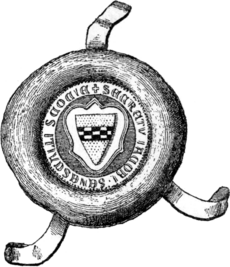
The pact happened at the same time as a big show of force by Richard in Ireland. He took hostages from Irish clans and replaced a king with someone he preferred. The Anglo-Irish nobles in the pact might have wanted naval support from Clann Domhnaill. It's possible Aonghus Mór helped with the Earl's actions.
Other people who signed the pact included members of the Stewart kindred. The Bruces and Stewarts also had interests in Ireland. The Stewarts eventually claimed lands that used to belong to John Balliol's family. The Stewarts' involvement might also have been about taking over the Clann Suibhne lordship in Argyll. Clann Suibhne had to leave Scotland and found safety in Ireland. This was because they had an alliance with Domhnall Óg.
Clann Domhnaill helped Domhnall Óg's son, Toirdhealbhach, defeat his half-brother Aodh in 1290. This meant Clann Domhnaill was supporting their relative against someone connected to Clann Suibhne. It's not certain if this fight was a direct result of the pact. But it seems likely that Aonghus Mór's part in the pact was about his clan's military strength. Alasdair Óg might have led Clann Domhnaill's support in Ireland.
Under King John Balliol
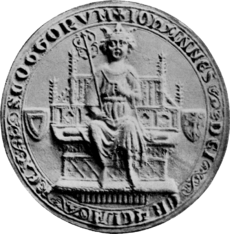
By the time King Alexander III died, Clann Domhnaill owned lands like Kintyre, Islay, southern Jura, and possibly Colonsay and Oronsay. While Aonghus Mór was often called by his father's name, Alasdair Óg and Aonghus Óg were usually called "of Islay." This title was linked to the lordship of the Isles.
In 1292, the English King allowed Aonghus Mór and Alasdair Óg to travel and trade between Scotland and Ireland safely. Also in 1292, a violent feud started between Clann Domhnaill and Clann Dubhghaill. This fight seems to have begun because Alasdair Óg married a woman from Clann Dubhghaill. The dispute was likely over her claims to land, specifically in Lismore. The identity of Alasdair Óg's wife, Juliana, is not fully known.
Even though Aonghus Mór, Alasdair Óg, and Alasdair Mac Dubhghaill promised King Edward I of England to stop fighting, the bitter conflict continued through the 1290s. King Edward ordered two Scottish guardians to ensure peace. One was the Steward of Scotland, and the other was John Comyn II, Lord of Badenoch. John Comyn was Alasdair Mac Dubhghaill's brother-in-law. This might mean the Steward and Clann Domhnaill were political allies.
In February 1293, King John of Scotland created three new sheriffdoms in the west. William II, Earl of Ross, became Sheriff of Skye in the north-west. Alasdair Mac Dubhghaill became Sheriff of Lorn in the central-west, covering much of Argyll. The Steward became Sheriff of Kintyre in the south-west. These new divisions showed how much royal power had grown in the west since 1266.
Even with the king's plans for more control and peace, the new sheriffs seemed to use their power against their local rivals. Clann Ruaidhrí had problems with the Earl of Ross. Clann Domhnaill had to deal with its powerful rivals, Clann Dubhghaill.
Clann Domhnaill Under Alasdair Óg
Working with the English
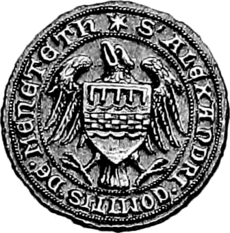
Aonghus Mór was last mentioned in 1293 and likely died around that time. Alasdair Óg's renewal of his father's gift suggests he had become chief by then. He was probably in his thirties when he took over.
To control Alasdair Mac Dubhghaill, who supported the Comyn-Balliol group, King Edward turned to Alasdair Óg. Alasdair Óg was working for the English King by March 1296. In April, he was an English agent in Kintyre. His job was to take control of Kintyre and give it to Malcolm le fitz l'Engleys. This meant Alasdair Óg was given power over an area that used to be under the Steward. The Steward had briefly fought the English but quickly gave up.
However, by September 10, King Edward gave authority to Alexander Stewart, Earl of Menteith. The Earl was given control over a large area from Ross to Rutherglen. He was ordered to take property from Alasdair Mac Dubhghaill and Eóin Mac Dubhghaill. He also had power over other nobles and towns. It's not known why the king changed his mind. The Earl had been captured in April but released in June. Perhaps the English wanted someone less involved in local politics. Or they might have wanted to divide power to limit Alasdair Óg's influence.
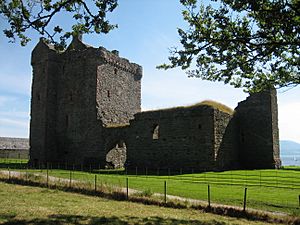
In a letter from around summer 1296, Alasdair Óg told the English King that he had taken control of the Steward's lands in Kintyre. He was also about to capture a castle. The castle is not named, but it might have been Dunaverty Castle or Skipness Castle. These were likely the Steward's main strongholds in Kintyre.
Alasdair Óg also said that no chief should lose their land without a proper legal process. However, Malcolm MacQuillan later had Dunaverty Castle. This suggests Alasdair Óg's letter was an unsuccessful attempt to stop Malcolm from gaining power in Kintyre. By early May, the Steward had surrendered to the English. It's unclear if Alasdair Óg knew this. His castle might have been taken by Alasdair Óg or simply handed over. In September 1296, King Edward ordered that Alasdair Óg be given money and land for his services.
Clan Conflicts
From about 1296 to 1301, Clann Dubhghaill was out of favor with the English King. The English King's supporters in Argyll were successful. The next record of Alasdair Mac Dubhghaill shows he had been imprisoned. He was released by King Edward in May 1297. King Edward might have hoped this release would control Alasdair Mac Dubhghaill's son, Donnchadh. Donnchadh had not sworn loyalty to the English King and was leading his family's resistance against Clann Domhnaill.
The fight between Clann Domhnaill and Clann Dubhghaill is described in two letters from Alasdair Óg to King Edward. In the first letter, Alasdair Óg complained that Alasdair Mac Dubhghaill had attacked his lands. Alasdair Óg also said he had defeated Ruaidhrí Mac Ruaidhrí. But Ruaidhrí's promise of loyalty to the English King was just a trick. Ruaidhrí's brother, Lachlann Mac Ruaidhrí, then attacked Alasdair Óg. Both brothers then raided Skye and Lewis and Harris.
At the end of the letter, Alasdair Óg said he was planning a counterattack. He asked King Edward to tell other nobles in Argyll and Ross to help him fight the king's enemies. On April 9, 1297, King Edward ordered the men of Argyll and Ross to help Alasdair Óg. He also made Alasdair Óg the king's representative in Lorn, Ross, and the Hebrides. This gave Alasdair Óg authority in Alasdair Mac Dubhghaill's old sheriffdom. If the king's order was a response to Alasdair Óg's letter, it means he wrote it in mid-March.
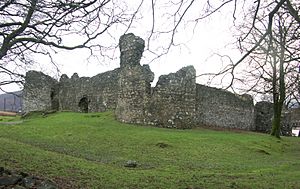
In the second letter, Alasdair Óg again asked the English King for help. He complained that Donnchadh, Lachlann, Ruaidhrí, and the Comyns were all united against him. Alasdair Óg said that the men of Lochaber had sworn loyalty to Lachlann and Donnchadh. He reported that he had forced Lachlann to surrender, but then Ruaidhrí attacked him.
Alasdair Óg also described an expedition where he chased his enemies to Inverlochy Castle. This was a Comyn stronghold and the main fort in Lochaber. There, he couldn't capture two huge ships, but he destroyed them. He called them the biggest warships in the Western Isles. Alasdair Óg also reported that he took control of a castle and land called "Glasrog" (probably Glassary). This was because the Steward was disloyal to the king. Alasdair Óg asked the English King for financial support to fight his many opponents. He reminded the king that he hadn't received the money he was promised.
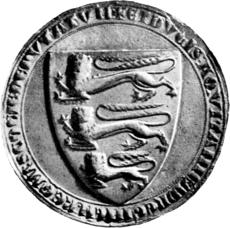
Alasdair Óg's letters show that Lachlann and Ruaidhrí wanted to take control of Skye and Lewis and Harris from the Earl of Ross. The first letter shows they initially raided the islands. The second letter suggests they invaded again, meaning they wanted to own the islands. The conflict between Clann Ruaidhrí and Clann Domhnaill shows that both clans wanted to take advantage of the Earl's absence. Both families wanted to add the islands to their own territories. For Clann Ruaidhrí, their actions were likely part of the conflict that started when the sheriffdom of Skye was created.
The letters also show that Lachlann and Ruaidhrí could split their forces and act somewhat independently. Alasdair Óg could defeat one brother at a time, but he was vulnerable to an attack from the other.
Alasdair Óg's second letter seems to be written after he received the king's order of April 9. It's not certain if the clan fighting continued after Alasdair Mac Dubhghaill was released in May. But it seems very likely given the strong dislike between them. If King Edward didn't expect the released chief to control his family, perhaps his release was meant to balance Alasdair Óg's power. This would keep Alasdair Óg in check.
The letters also show that even though King Edward gave administrative power to Alexander Stewart in the northwest, Alasdair Óg was actually carrying out English royal authority there. However, even though Alasdair Óg was supposedly working for the king, local rivalries and self-interest were the real reasons for political alliances. It wasn't about being anti-English. The English King favoring Alasdair Óg over the Steward and Clann Dubhghaill would have caused anger. It was clear that King Edward couldn't expect much authority without getting these two unhappy groups on his side.
Death of Alasdair Óg

In 1299, several Irish historical records (annals) describe a battle between Clann Domhnaill and Clann Dubhghaill. In this battle, Alasdair Mac Dubhghaill killed a member of Clann Domhnaill named Alasdair. The 17th-century Annals of the Four Masters says this man was "the best man of his tribe in Ireland and Scotland for hospitality and prowess." The 15th-century Annals of Ulster states he was killed "with countless numbers of his own people around him." This slain man appears to have been Alasdair Óg himself. The accounts suggest his death happened during his ongoing conflict with Clann Dubhghaill.
If a 17th-century account is true, Clann Dubhghaill also defeated another rival in the 1290s. This source claims that Eóin Mac Dubhghaill killed Cailéan Mór Caimbéal. Cailéan Mór died after King Edward recognized him as an official in Loch Awe and Ardscotnish in September 1296. This suggests he also worked for the English against Clann Dubhghaill. So, both Alasdair Óg and Cailéan Mór seem to have died fighting Clann Dubhghaill while trying to extend King Edward's power into Argyll.
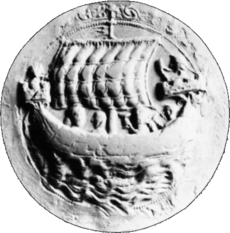
Alasdair Óg's death in 1299 seems to explain why his younger brother, Aonghus Óg, took action against Clann Dubhghaill. For example, in 1301 or 1310, Aonghus Óg asked the English King if he and Hugh could fight Alasdair Mac Dubhghaill. He also asked the king to grant Lachlann and Ruaidhrí their ancestral lands. They were helping Aonghus Óg's English-allied forces. Another letter from Hugh to King Edward shows that Hugh, Eóin Mac Suibhne, and Aonghus Óg were fighting Clann Dubhghaill at sea that year.
Aonghus Óg called himself "of Islay" in his letter. This could mean he was acting as chief of Clann Domhnaill and succeeded Alasdair Óg. However, the exact succession of Clann Domhnaill is unclear. For example, a man named Domhnall attended a parliament in 1309 and was also called "of Islay." This might mean he was the chief then. His identity is also uncertain. He could have been an older brother of Aonghus Óg, a cousin, or a son of either.
Further evidence of a disputed family succession is a man named Alasdair of the Isles. He received land from King Robert I, including the islands of Mull and Tiree, which used to belong to Clann Dubhghaill. This man could have been a son of Aonghus Óg, or a nephew, possibly a son of Alasdair Óg himself. The fact that he received former Clann Dubhghaill islands might mean he was Alasdair Óg's son. He would have had a claim to these lands through his mother, who was from Clann Dubhghaill.
There is no record of a royal grant for the lordship of Islay. This could mean that when Alasdair Óg died, the lordship was automatically inherited by a son, possibly Alasdair of the Isles. This Alasdair might be the same Clann Domhnaill chief who died in 1318 while supporting the Bruce campaign in Ireland. The 16th-century Annals of Loch Cé calls him "Mac Domnaill, King of Argyll." Other Irish annals also mention this. This title, "King of Argyll," shows the big impact the rise of the Bruce family had on their enemies like Clann Dubhghaill. Until its fall in 1309, Clann Dubhghaill was closely linked to the lordship of Argyll. So, this title might mean that a son of Alasdair Óg inherited lands from both Clann Domhnaill and Clann Dubhghaill.
Descendants
Alasdair Óg is the ancestor of the Clann Alasdair branch of Clann Domhnaill. This family is also known as Clan Alexander. Historical records show he had at least six sons: Eóin Dubh, Raghnall, Toirdhealbhach, Aonghus, Gofraidh, and Somhairle.
After his death, Alasdair Óg's sons became leaders of gallowglass (mercenary warriors) in Ireland. Three of them are mentioned as commanders in Irish historical records. All of them founded important Irish gallowglass families. So, Alasdair Óg's descendants formed the main gallowglass families of Clann Domhnaill. The first to be recorded as a commander was Eóin Dubh, who died in 1349.
Another possible son of Alasdair Óg is Ruaidhrí of Islay. King Robert I took his lands in 1325. It's not certain who his parents were. He could have been from Clann Ruaidhrí or Clann Domhnaill. If Ruaidhrí of Islay was Alasdair Óg's son, his loss of lands might explain why Clann Alasdair moved to Ireland as mercenary commanders. This could mark the time when Alasdair Óg's descendants stopped holding power in the Hebrides. Another family descended from Alasdair Óg is likely Clann Alasdair of Loup in Kintyre.
The decline of Alasdair Óg's family line, which was the older branch of Clann Domhnaill, might explain why Aonghus Óg's family line became more powerful. If Ruaidhrí of Islay represented Alasdair Óg's line in 1325, his forfeiture likely cleared the way for Aonghus Óg's son, Eóin. Before King Robert I's reign ended, Eóin managed Islay for the Scottish Crown. He eventually took the title Lord of the Isles.
Some stories about Alasdair Óg, found in the 17th-century Sleat History, are different from more accurate historical accounts. For example, the Sleat History says Alasdair Óg was "always" an enemy of King Robert I. It claims he constantly fought alongside Eóin Mac Dubhghaill against the king. It also says Alasdair Óg was captured at Castle Sween and died there as a prisoner. However, the more accepted view is that he was always loyal to the Bruces. His younger brother, Aonghus Óg, also always supported King Robert I in "all his wars."
This changed view of Alasdair Óg seems to have been created to make the branch of Clann Domhnaill descended from Aonghus Mor's younger brother, Alasdair Mor, look better. It did so by downplaying Alasdair Óg's reputation. Because of this, the history of the Clann Alasdair branch of the clan is ignored by the Sleat History.
See Also
- Lord of Islay
- Clann Domhnaill
- Aonghus Mór mac Domhnaill, Lord of Islay
- Aonghus Óg Mac Domhnaill
- Clann Dubhghaill
- Turnberry Band
Images for kids


